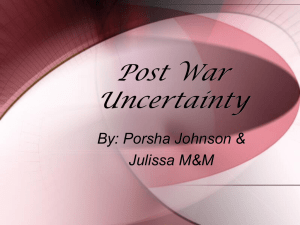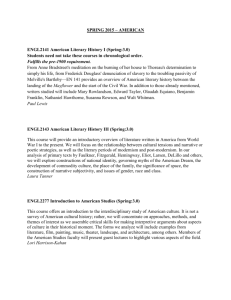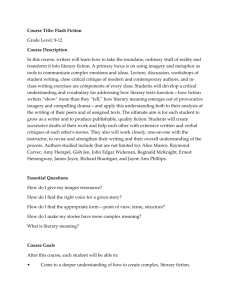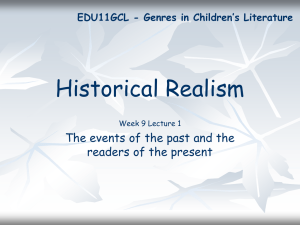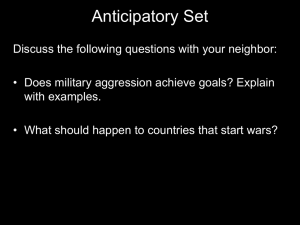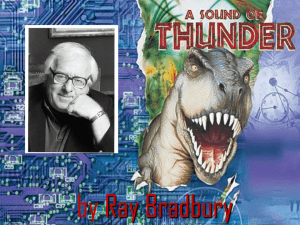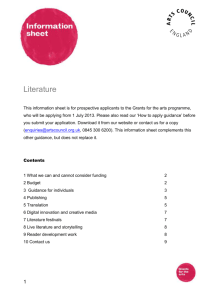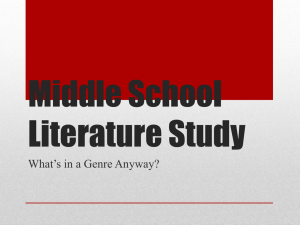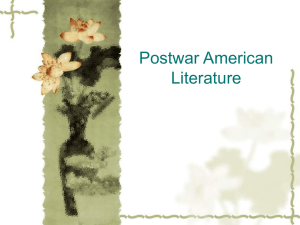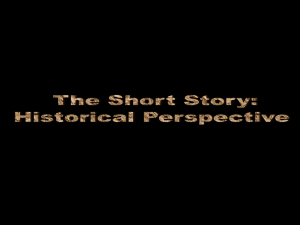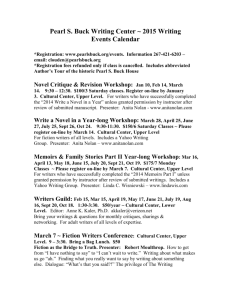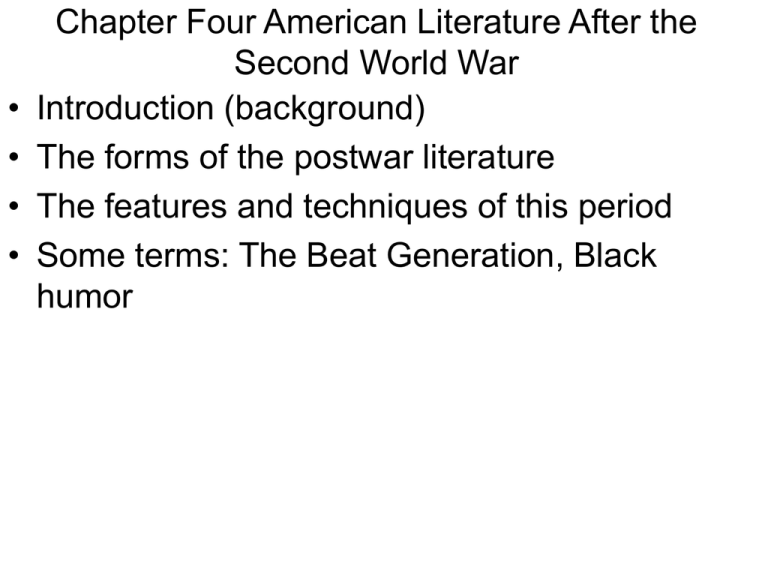
•
•
•
•
Chapter Four American Literature After the
Second World War
Introduction (background)
The forms of the postwar literature
The features and techniques of this period
Some terms: The Beat Generation, Black
humor
introduction
• American literature after the Second World War
is usually referred to, more precisely, as
postwar of post-modernistic literature, as this
division of literary periods is more of social and
political than literary consideration. The postwar
literature, although short in time, is
kaleidoscopic. At least two factors have
contributed to this kaleidoscopicalness 五花八
门,万花筒: one is social, the other literary or
aesthetical. (P457-466)
• What happened immediately after the Second
World War in the USA and other parts of the
world exerted a tremendous influence on the
mentality of Americans. It changed man’s view
of himself and the world as well.
• First of all, the dropping of an atomic bomb over
Hiroshima in Japan shocked the whole world
and made possible the destruction of the
Western civilization.
• Then a mutual fear and hostility grew between
the Eastern and Western countries with the
Cold War, the effect of which could be felt in the
form of McCarthyism in the USA.
• Besides, the Korean War and the Vietnam War
broadened the gap between the government
and the people.
• The assassination of John.F. Kennedy, and of
Martin Luther King, spokesman of the American
Civil Rights Movement, the resignation of Nixon
because of the Water-Gate scandal, etc.
intensified the terror and tossed the whole
nation again into the grief and despair.
• The impact of these changes and upheavals on
the American society is emotional.
• People start to question the role of science in
human progress and the fear of the misuse of
modern science and technology is spreading.
They no longer believe in God but start to
reconsider the nature of man and man’s
capacity for evil. They begin to think of life as a
big joke or an absurdity. The world is even more
disintegrating 分裂 and fragmentary不完整
and people are even more estranged 疏远的
and despondent绝望的.
Postwar Poetry
• World War II ended two decades of vigorous
literary activity in the USA.
• The postwar poets, with Robert Lowell in the
lead, would typically write about an object or a
situation which could express or classify their
own feeling, showing a growing sense of
resistance to the existing culture and at the
same time an assertion of the self.
• Poets in 50s and the 60s were grouped under
different titles, and among them the outstanding
ones are Gary Snyder, who tends to liberate
poetry from the academy and make it popular
among the ordinary people, and Allen Ginsberg,
whose “Howl (1956)” became the manifesto of
the Beat Movement.
Postwar Fiction
• American fiction from 1945 onwards is a bigger
story than poetry and drama.
• First of all, a group of new writers who survived
the war wrote about their traumatic experience
within the military machined and on European
and Pacific battlefields, among whom we have
Norman Mailer and Herman Wouk. Robert
Penn Warren and Flannery O’Conner are
representatives of the talented Southern writers,
who followed Faulkner’s footsteps in portraying
the decadence and evil in the Southern society
in a Gothic manner.
• By the 1950s a significant group of JewishAmerican writers had appeared and one of
them was Saul Bellow. Their work, drawing on
the Jewish experience and tradition, examined
subtly the dismantling of the self by an
intolerable modern history.
• Black fiction began to attract critical attention
during the period, too, the two major figures are
Richard Wright and Ralph Ellison, both of whom
captured the wide attention of the white readers
by truthfully, openly, and shockingly describing
the life of black people as they knew if from
their own experience.
• For the first time in the history of American writings,
African-Americans started to question their identity as
a group and as an individual美国黑人第一次对他们的
群体和个人的身份开始质疑.
• Other important writers who were writing at the time
include J. D. Salinger and John Updike. Salinger is
considered to be a spokesman for the alienated youth
in the post-war era and his The Catcher in the Rye<
裸麦田里的接手>is regarded as a students’ classic.
Updike’s Rabbit novels examine the middle-class
values and portray the troubled relationships in
people’s private life and their internal decay under the
stress of the modern times. 在现代社会重压下人们私
生活复杂关系和内心世界的败坏.
• American fiction in the 1960s and 1970s proves
to be different from its predecessors in that the
writers started to depart from the conventions of
the novel writing and experimented with some
new forms. Hence, it is always referred to as
“new fiction,” with Kurt Vonnegut, Joseph Heller,
John Bath, and Thomas Pynchon at its forefront.
Roughly speaking, these writers shared almost
the same belief that human beings are trapped
in a meaningless world and that neither God
nor man can make sense of the human
condition. 这些作家普遍认为人类在毫无意义的
世界里沉浮,上帝与人类无法弄懂人类环境有什
么意义.
• What’s more, this absurdist vision is integrated
with an absurd form, which is characterized by
comic exaggerations, ironic uses of parodies滑
稽的模仿, multiple realities, often twodimensional characters, and a combination of
fantastic events with realistic presentations.
• 这种荒诞的观点与荒诞的形式结合,运用喜剧夸
张、滑稽模仿中的反讽,把难以想象的事物用现
实的手法表现出来
• In general terms, much serious literature written
from 1912 onwards attempted to convey a
vision of social breakdown and moral decay
and the writer’s task was to develop techniques
that could represent a break with the past. Thus,
the defining formal characteristics of the
modernistic works are discontinuity and
fragmentation.
• 总之,1912年以后许多严肃文学都力图表达社
会崩溃、道德沦丧的观点,作家的任务是发展使
用新技巧,告别老传统。因此美国现代文学的特
点是反传统,求创新。
The features of Postwar literature
• Compared with earlier writings, especially those of the
19th century, modern American writings are notable
for what they omit – the explanations, interpretations,
connections, an summaries.
• A typical modern work will seem to begin arbitrarily, to
advance without explanation, and to end without
resolution.现代文学的特点是开端任意,发展不做解释
以及没有结果的收场. The book is no longer a record
of sequence and coherence but a juxtaposition并置 of
the past and the present, of the history and the
memory, or a book of fragments drawn from diverse
areas of experience, including areas previously
deemed inappropriate for literature, such as the life of
the street or of the mind.
Modernistic techniques
• Modernistic techniques and manifestos were initiated
by poets first and later entered and transformed fiction
in this period as well.
• Like the poets, prose writers strove for directness,
compression, and vividness and were sparing of
words. The average novel became quite a bit shorter
than it had been in the 19th century. New significance
was given to the short story, which had previously
been thought of as a relatively slight, artistic form.
• If realistic fiction achieved its effects by accumulation
and saturation, modern fiction preferred
suggestiveness暗示. Traditional fiction featured an
authoritative narrator in telling a story, while modern
fiction tended to employ the first person narration or
limit the reader to the “central consciousness” or one
character’s point of view.
The Beat Generation
• It is also called the Beats, is a term referring to
certain American artists and writers who were
popular during the 1950s. Composed mostly of
some jobless young intellectuals and vagrants,
and greatly influenced by Niezsch’s “will to
power”, Freudian theory of Psychoanalysis and
Sartre’s existentialism, they rejected traditional
social and artistic forms, regarding “reason” as
the source of misery of the contemporary world.
Therefore they turned to sex, alcohol, drugs,
fantasies and any other sensual pleasures,
hoping to get away from the tradition and reality
they refused to accept.
black humor
• In literature, drama, and film, grotesque or
morbid humor used to express the absurdity,
insensitivity, paradox, and cruelty of the modern
world. Ordinary characters or situations are
usually exaggerated far beyond the limits of
normal satire or irony. Black humor uses
devices often associated with tragedy and is
sometimes equated with tragic farce.

